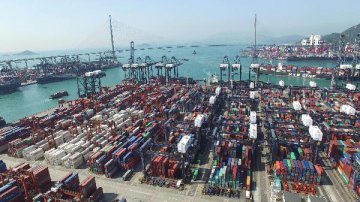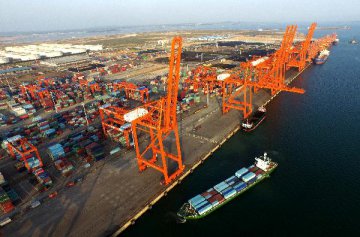
China faces increasing pressure and uncertainties on foreign trade in the second half year. Though the Federal Reserve delayed the rates hike not long ago, there still might be a rates hike in the second half year. The exchange rate of yuan against the U.S. dollar is expected to remain in a steady range, and thus it likely appreciates against other currencies, putting downside pressure on export. Brexit also will impact the world economy, resulting in increased uncertainties for China’s overseas market demand in the second half year. Analysts believe that in this context, improvement of the economy of resource countries and impetus from direct foreign investment are probably important supporting factors for China’s export in the second half year. And the construction of “Belt and Road” and free trade zones are also drives for export.
Growth of export faces pressure
Industry insiders anticipated that China’s export will continue the slightly falling trend in the following few months, and the foreign trade industry overall remain weak.
“There might be great pressure on the growth rate of export in the third quarter, as the precursor indicators of foreign trade are not optimistic. China's Export Leading Index (ELI) hit 33.1 in May, down 0.7 from the previous month. The outlook of economic recovery of major economies in the world still confront with huge uncertainties. Particularly, the recent employment data of the U.S. is far below expectation. This means that China’s overseas market demand fundamentally has not improved,” said Liu Tao, senior analyst with the finance research center of the Bank of Communications.
“According to recent investigation carried out by the Ministry of Commerce (MOFCOM) in 20 provinces and municipalities, enterprises generally indicated that the overall foreign trade situation during this year is trickier than last year. The monthly export data of last year shows that the export from last June to December ranged from 189.5 to 223 billion U.S. dollars. This relatively high reading means that it is difficult to realize year on year positive growth during the third quarter this year and afterwards,” said Liu.
As for import, Liu indicated that the growth rate of import during the third quarter may fluctuate. Based on the latest core personal consumption expenditures (PCE) price index and non-agriculture employment, which were lower than expected, the bottom line of Fed rates hike can hardly be reached in the near term. Impacted by lower-than-expected U.S. economy, prices of international commodities such as crude oil may see a periodic pullback. And China’s import quantities may fluctuate in response to changing domestic investment demand and inventory.
“Import will continue to be limited by demand in the second half year,” said Xie Yaxuan, chief analyst of macroeconomic research with China Merchants Securities. “In the second half year, China’s domestic demand may still be weak. But if the prices of commodities remain above the current level, it will contribute the year on year growth of import. Since China’s is a major importer rather than exporter of commodities, the stabilizing and rebounding of commodity prices in global market may also narrow China’s trading surplus this year in comparison with last year.”
The China Economic Outlook Analysis 2016 recently released by the Chinese Academy of Social Sciences (CASS) pointed out that China’s import might reduce this year, and the growth rate of import throughout the year is expected to drop 5 percent to 7 percent.
Brexit impact likely to spread
Insiders believed that the export will face the increasing pressure in the second half year. On one side, the Fed may raise the rate in the second half year, and U.S. dollar index will consolidate with uptrend. In order to prevent financial risk, CNY/USD exchange rate will be controlled in a certain range for stabilization, which will cause RMB appreciation against other currencies, and brings in downtrend pressure on export. On the other side, the EU is China’s largest trade partner, and China’s foreign trade will suffer a big uncertainty, if the UK finally exits from the EU. Based on statistics from Ministry of Commerce, the EU became the biggest trade partner to China for a consecutive 11th year in 2015, and China, the biggest one to the EU for constantly 12 years.
Additionally, since this year, the rise of trade protectionism increasingly blocks China’s export. Under the constantly depressed trade worldwide, the rise of trade protectionism implemented by developed countries may press China’s export to them, according to Xie. The Europe, the U.S. and Japan have initiated anti-dumping against China’s steel since 2016, showing that, along with depressing global demands, free trade concept weakens, trade protectionism obviously worsens, China’s export to developed nations is difficult to greatly improve in a short term, and economic improvement of resource countries and outward foreign direct investment (OFDI) will possibly become the important support for China’s export in the second half year.
Motivation and pressure coexist
Although the pressure will not ease, the export will still gain some support on the whole.
Xie indicated that export will jointly achieve motivation and suffer pressure. The “B&R” is likely to gradually become the significant support for export, which has helped China access to two channels. One is that investment and construction of the countries along the “B&R” expand domestic demands, and create channel advantage for Chinese enterprises in terms of needed equipment, raw materials, products and etc. The second is that the said nations provide a space for China to export consumer goods and labor intensive products in the future after establishing economic cooperation.
Xie said, from another view, the OFDI of China’s non-financial industry indeed plays a leading role to drive the export in recent years, and so does the “B&R”. Since this year, China’s OFDI increases obviously, with 73.52 billion U.S. dollars accumulatively from January to May, up by 61.9 percent year on year. It is expected to push the export improvement in the second half year.
The FTZ has increasingly driven China’s export. Taking Sino-Korea FTZ as an example, the signature and implementation of Sino-Korea Free Trade Agreement plays a positive role to boost the mutual relationship between Korea and China. Based on MOC’s statistics, 50 percent of interviewed enterprises indicated that export to Korea has increased or greatly increased after the agreement takes into effect; and 57 percent of them said that people requiring product information or orders increase or soar.
According to suggestions from Chi Fulin, head of China Institute for Reform and Development, and also vice president of China Society of Economic Reform, China should initiate a new round of FTZs construction based on the “B&R”, and fight against the trade protectionism. He also suggested that China should build up multilateral, bilateral, regional and global FTZs along the “B&R”, establish energy & economic communication with central European countries, and construct tourism-based economic communication with Asian and European countries.
Translated by Adam and Jelly





















Latest comments